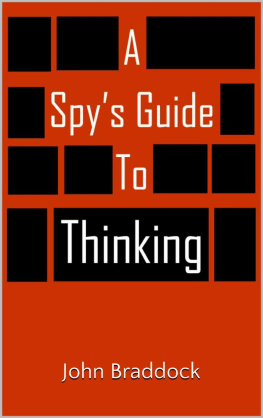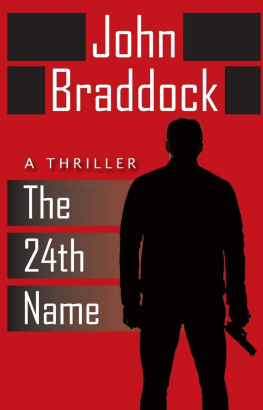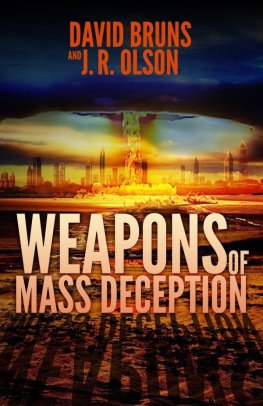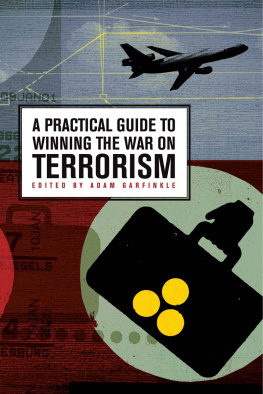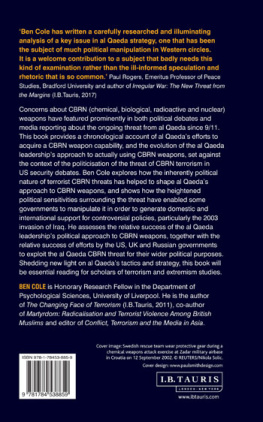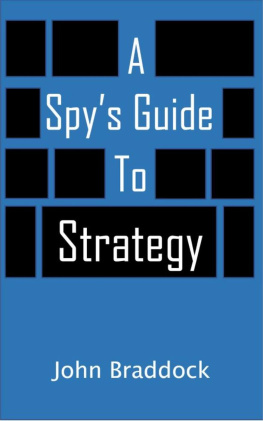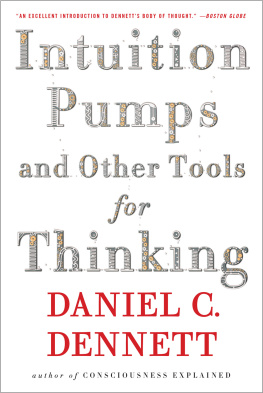A
Spys Guide
to
Thinking
by
John Braddock
www.spysguide.com
This ebook is licensed for your personal enjoyment only. This ebook may not be re-sold or given away to other people. If you like to share this book with another person, please purchase an additional copy for each person you share it with.
Copyright 2015 John Braddock . All rights reserved. Including the right to reproduce this book or portions thereof, in any form. No part of this text may be reproduced in any form without the express written permission of the author.
This does not constitute an official release of CIA information. All statements of fact, opinion, or analysis expressed are those of the author and do not reflect the official positions or views of the Central Intelligence Agency (CIA) or any other U.S. Government agency. Nothing in the contents should be construed as asserting or implying U.S. Government authentication of information or CIA endorsement of the authors views. This material has been reviewed solely for classification.
How To Think
Spy gadgets are fun. Not Qs rocket cars and jetpacks. Not James Bonds remote detonators. The real world stuff. Crazy, complicated things. Fun, yes. Interesting, yes.
But if youre a spy in the field, you start to think. Do I want to bet lives my life on a gadget working?
You say no to a lot of gadgets. You turn down most of what they send you. When you get one that might be good, you ask questions. Does it work? Does it work in a simple way? Will it break?
Even then, you pause. You want someone else to use it first. Just to be sure. You learn the best things arent the new things. Used things are better. Worn things. Things that have worked in the field. For fifty, sixty years, if possible. Updated, sure. But tested. Proven. If the mission fails because a gadget breaks, its not Q at risk. Its you.
When you find something that works, its gold. The thing does its job, you do yours. You go out and be a spy. Maybe even save the world.
This little book is about thinking, but its like a gadget. It has tools that work. In a simple way. Without breaking. Even better, the tools have been used for a long time. Updated, sure. But used successfully by people and organizations for many years.
The tools here are most useful under pressure. First, because they stop us from only reacting. They bring focus. They help us resist the takeover of the lizard brain. They remind us what sets us apart: We think.
Lastly, theyve been tested in a variety of environments with a variety of people. With varying levels of complexity. Different situations, different people, different needs.
Bottom line: They work.
On that, I bet my life.
---------
Early morning in Europe. Not the worst place. Not the best. A weekend. Just after public transport opened. Quiet. A good time for a spy to meet a source.
I found a seat in the back of a subway car. Pulled out a phone to check for last minute communications. A guy saw me do it.
Normally, not a big deal. Lots of people dressed like me. Looked like me. Had their phones out. But the guy chose me.
Let me see your phone, he said in the local language.
I ignored him.
Let me see your phone, he said again.
I looked at the guy. Started thinking. Collected data.
The guy: My height. A little heavier. Wiry. Some muscle under a thin coat. Cheap shoes. Jeans. Non-native ethnicity. Aggressive posture.
He stood in the walkway. Blocked the exit. His gaze was intense. But his eyes were dancing and unfocused.
Time for some analysis.
Pretty clear that Let me see your phone equaled Let me steal your phone.
More analysis needed. I started on the usual cycle of questions when approached by anyone in a foreign country.
The first question was always the same: Does this guy know Im a spy?
---------
Thinking, in its simplest form, looks like this:

Notice the end: Action. If thinking doesnt end with action, its useless. Taking action is why we think. If youre thinking just to think, thats useless, too.
Back up another step: Decision. Were deciding on a range of options. Simple.
Back up another: Analysis. Were sifting through the information needed to make a decision. Were judging the credibility of the information. Its reliability. Its usefulness for the decision. And were combining the new data with what we already know.
Then were at the beginning: Data. Were collecting data on the world. Were gathering what we think will be useful down the line. The information we need to analyze. To decide. To take action.
Thats the chain of thinking: D-A-D-A. Getting data leads to analysis. Analysis leads to a decision. A decision leads to an action. Simple. Thats how thinking works.
Its not just people who think this way. Organizations, large and small, do it, too. Instead of the process being in one head, its spread among many. Some gather data. Some analyze it. Others make decisions. Still others take action. Some organizations do this well, some dont.
I was part of the thinking process in the largest organization of all: the U.S. government. What I did was collect data. The front end of this chain. It was secret data. Risky data. The kind of data that people can die for. People like me. Because secret data starts a process that leads to certain kinds of action. Sometimes, it leads to war.
One nation learns about a rivals weakness. Another discovers that the first is planning an invasion. A third tries to pre-empt with negotiations. A fourth takes advantage of the confusion and starts a war.
I collected secret data so the U.S. could make the right decisions. Take the right actions. Hopefully, before things spun out of hand. Its the game before the game. What happens before news becomes news. Thats intelligence-gathering. Its collecting data to feed into a governments thinking process.
To do my job, I also did the four parts myself. Collect the data on the intelligence target. Analyze it. Make a decision on the approach. Take action to get the intelligence.
Not thinking well is dangerous. Because the spy world is risky and constantly changing. New data to collect. More analysis to do. New options to evaluate. New actions to take.
Even when you least expect it.
---------
Does he know Im a spy?
He had spoken to me in the local language. A good sign that he didnt know I was a spy. Or at least, an American spy.
I had to be sure. Everything I would do next depended on that answer.
Collected more data. First: Whats he looking at?
My phone. Mostly my phone, anyway. A quick glance at my face just then.
The phone is what he wants. Doesnt mean he doesnt know Im a spy. Maybe his job is to get my phone because he knows Im a spy. If so, would he be so obvious? A follow-up: Is he here to distract me from something else?
More data needed. On the environment.
The first thing to know: Was the guy alone?
I looked around.
Sleepy faces in the seats. A young guy two rows away watching. A surprised look on his face. No tenseness in the shoulders. No readiness. No slight shift of weight. No preparation for movement. Hes watching because this guy asked to see my phone. Not a normal occurrence. Hes interested but not expecting to do anything. The young guys not planning to get involved.
In front of him, an old woman in a scarf. A bag on her lap. A quick turn of the head, then back around. The Russians are famous for using old women as surveillants, but not the locals here. Doubtful she was with the security services. Shes trying to avoid attention. She doesnt want to get hurt.
Next page
